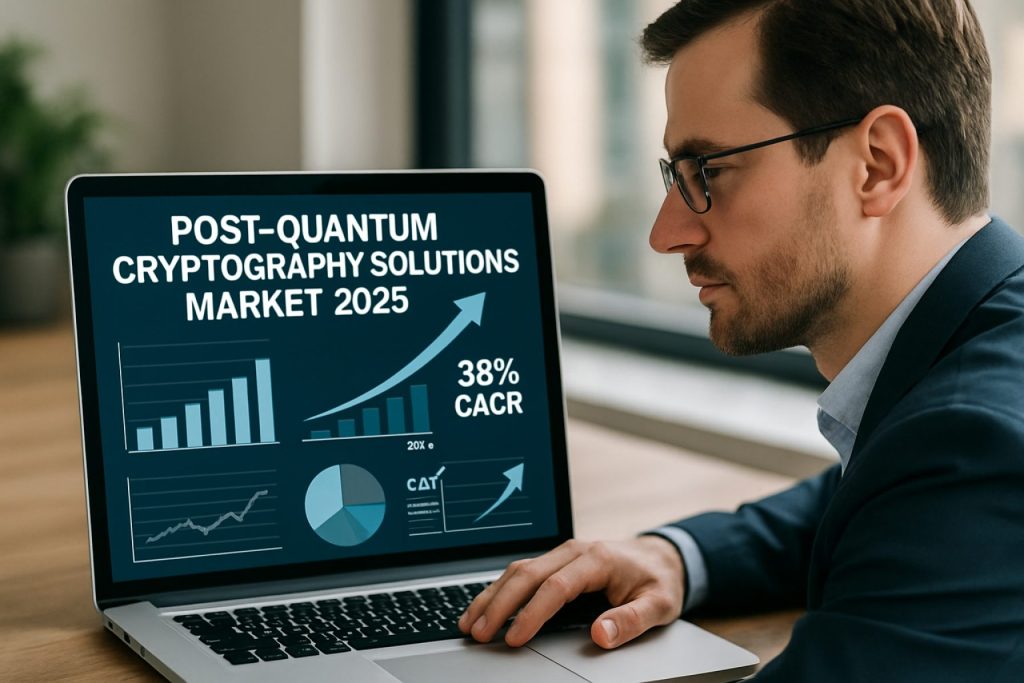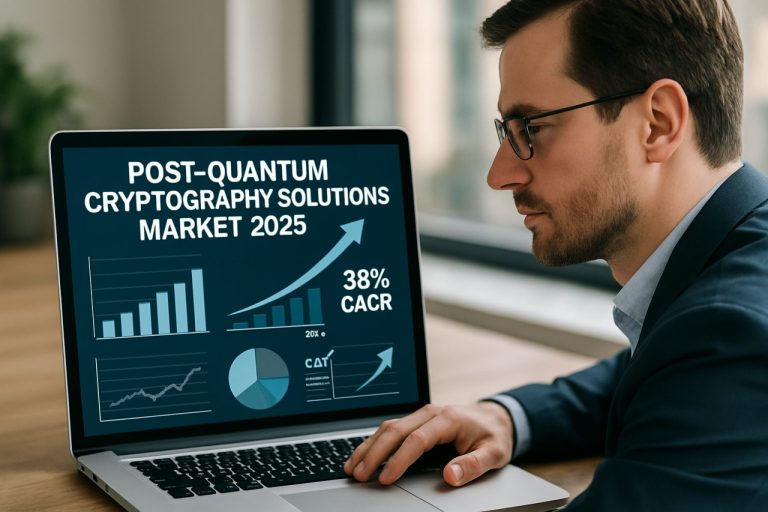
Post-Quantum Cryptography Solutions Market Report 2025: In-Depth Analysis of Technology Trends, Competitive Dynamics, and Global Growth Projections. Discover Key Drivers, Regional Insights, and Strategic Opportunities Shaping the Next Era of Cybersecurity.
- Executive Summary and Market Overview
- Key Technology Trends in Post-Quantum Cryptography
- Competitive Landscape and Leading Solution Providers
- Market Growth Forecasts and CAGR Analysis (2025–2030)
- Regional Market Analysis and Adoption Patterns
- Future Outlook: Innovations and Strategic Roadmaps
- Challenges, Risks, and Emerging Opportunities
- Sources & References
Executive Summary and Market Overview
Post-quantum cryptography (PQC) solutions represent a rapidly evolving segment within the broader cybersecurity market, driven by the imminent threat posed by quantum computers to classical cryptographic algorithms. As quantum computing capabilities advance, traditional public-key cryptosystems such as RSA and ECC are expected to become vulnerable to quantum attacks, necessitating the adoption of quantum-resistant algorithms. PQC solutions are designed to secure digital communications, data storage, and authentication processes against both current and future quantum-enabled threats.
The global market for post-quantum cryptography solutions is projected to experience robust growth through 2025, fueled by increasing investments in quantum computing, heightened regulatory scrutiny, and the proactive stance of governments and enterprises toward future-proofing their cybersecurity infrastructure. According to Gartner, 60% of organizations are expected to struggle with the transition to PQC by 2025, highlighting both the urgency and the complexity of the migration process.
Key market drivers include the U.S. National Institute of Standards and Technology (NIST) standardization process, which is finalizing the selection of quantum-resistant algorithms for widespread adoption. The NIST initiative has accelerated R&D and commercialization efforts among leading cybersecurity vendors and startups. Major technology companies such as IBM, Microsoft, and Google are actively integrating PQC into their product portfolios, while specialized firms like Quantinuum and ISARA are developing dedicated PQC toolkits and migration services.
The market landscape is characterized by a mix of pilot deployments, proof-of-concept projects, and early commercial rollouts, particularly in sectors with high regulatory requirements such as finance, government, and critical infrastructure. The European Union’s Quantum Flagship and similar initiatives in Asia-Pacific are further catalyzing adoption and cross-border collaboration.
In summary, the post-quantum cryptography solutions market in 2025 is defined by rapid innovation, regulatory momentum, and a growing recognition of the need for quantum-safe security. Organizations that proactively engage in PQC migration are expected to gain a strategic advantage as the quantum era approaches.
Key Technology Trends in Post-Quantum Cryptography
Post-quantum cryptography (PQC) solutions are rapidly evolving as organizations prepare for the advent of quantum computers capable of breaking traditional public-key cryptosystems. In 2025, several key technology trends are shaping the development and adoption of PQC solutions, driven by both regulatory momentum and industry innovation.
One of the most significant trends is the standardization of PQC algorithms. The National Institute of Standards and Technology (NIST) is finalizing its selection of quantum-resistant algorithms, with the first set of standards expected to be published in 2024 and widespread implementation anticipated throughout 2025. This standardization is catalyzing the integration of PQC into commercial products and government systems, as vendors align their offerings with NIST’s recommendations.
Another trend is the emergence of hybrid cryptographic solutions. Many organizations are deploying hybrid schemes that combine classical and post-quantum algorithms to ensure backward compatibility and layered security during the transition period. Companies such as IBM and Microsoft are incorporating hybrid PQC into their cloud and enterprise security platforms, enabling customers to adopt quantum-safe encryption without disrupting existing workflows.
Interoperability and performance optimization are also at the forefront of PQC solution development. As PQC algorithms often have larger key sizes and higher computational requirements, vendors are focusing on optimizing implementations for efficiency and seamless integration with existing protocols such as TLS, VPNs, and digital signatures. The European Telecommunications Standards Institute (ETSI) and Internet Engineering Task Force (IETF) are actively working on standards and best practices to facilitate interoperability across diverse platforms and devices.
Additionally, there is a growing emphasis on hardware-based PQC solutions. Semiconductor manufacturers like Qualcomm and Intel are developing chipsets with built-in support for quantum-resistant algorithms, targeting applications in IoT, mobile devices, and critical infrastructure. This hardware integration is expected to accelerate the adoption of PQC by providing robust, low-latency cryptographic operations at the edge.
Overall, 2025 marks a pivotal year for post-quantum cryptography solutions, with industry-wide collaboration, regulatory guidance, and technological innovation converging to drive the transition toward quantum-safe security.
Competitive Landscape and Leading Solution Providers
The competitive landscape for post-quantum cryptography (PQC) solutions in 2025 is rapidly evolving, driven by the urgent need to secure digital infrastructure against the future threat posed by quantum computers. As quantum computing capabilities advance, traditional public-key cryptosystems such as RSA and ECC are increasingly vulnerable, prompting governments and enterprises to accelerate the adoption of quantum-resistant algorithms.
A significant catalyst in the market has been the National Institute of Standards and Technology (NIST)’s ongoing standardization process for PQC algorithms. In 2022, NIST announced the first group of algorithms selected for standardization, including CRYSTALS-Kyber (for key establishment) and CRYSTALS-Dilithium (for digital signatures), with final standards expected by 2024-2025. This has spurred a wave of product development and integration efforts among cybersecurity vendors and technology providers.
Leading solution providers in the PQC space include established cybersecurity firms, cloud service providers, and specialized cryptography startups. IBM has been at the forefront, integrating PQC algorithms into its cloud and hardware security modules, and collaborating with industry partners to pilot quantum-safe solutions. Microsoft has incorporated PQC into its Azure Key Vault and is actively contributing to open-source PQC libraries. Google has conducted large-scale experiments with hybrid post-quantum TLS in Chrome and its internal infrastructure, signaling readiness for broad deployment.
- Quantinuum (a merger of Honeywell Quantum Solutions and Cambridge Quantum) offers enterprise-grade quantum-safe encryption tools and consulting services, targeting sectors such as finance and government.
- Thales and Entrust have launched PQC-enabled hardware security modules and certificate management platforms, supporting hybrid cryptography to ease migration.
- Startups like Post-Quantum and ISARA are providing software development kits and integration services for PQC, focusing on agility and compliance with emerging standards.
The competitive dynamic is characterized by rapid innovation, strategic partnerships, and a race to achieve compliance with NIST standards. Vendors are differentiating through interoperability, ease of integration, and support for hybrid cryptographic schemes that combine classical and quantum-safe algorithms. As regulatory pressure mounts and quantum-readiness assessments become standard, the market is expected to consolidate around providers with proven, standards-compliant, and scalable PQC solutions.
Market Growth Forecasts and CAGR Analysis (2025–2030)
The market for post-quantum cryptography (PQC) solutions is poised for robust expansion between 2025 and 2030, driven by escalating concerns over quantum computing’s potential to break classical encryption and the proactive stance of governments and enterprises in future-proofing their cybersecurity infrastructure. According to projections by Gartner, by 2027, 50% of cybersecurity leaders in large enterprises will have adopted quantum-resistant cryptography, up from less than 2% in 2023, indicating a steep adoption curve that will accelerate market growth in the latter half of the decade.
Market research from MarketsandMarkets estimates the global PQC market size will grow from approximately USD 0.5 billion in 2025 to over USD 3.8 billion by 2030, representing a compound annual growth rate (CAGR) of around 50%. This exceptional CAGR is attributed to several converging factors:
- Regulatory Mandates: The U.S. National Institute of Standards and Technology (NIST) is finalizing standards for quantum-resistant algorithms, with compliance deadlines expected to drive rapid enterprise adoption starting in 2025.
- Rising Quantum Threat Awareness: High-profile warnings from agencies such as the Cybersecurity and Infrastructure Security Agency (CISA) and NSA have heightened urgency, prompting organizations to accelerate PQC pilot projects and investments.
- Vendor Ecosystem Maturation: The emergence of specialized vendors and integration of PQC into mainstream security products by companies such as IBM and Microsoft is lowering barriers to adoption and expanding the addressable market.
Regionally, North America is expected to lead PQC adoption due to early regulatory action and concentration of critical infrastructure, while Europe and Asia-Pacific will see accelerated growth as local standards and compliance frameworks emerge. The market’s trajectory will be shaped by the pace of quantum computing advancements, regulatory enforcement, and the ability of vendors to deliver scalable, interoperable PQC solutions.
Regional Market Analysis and Adoption Patterns
The regional market analysis for post-quantum cryptography (PQC) solutions in 2025 reveals significant disparities in adoption patterns, driven by regulatory frameworks, technological readiness, and sectoral priorities. North America, particularly the United States, leads the global PQC market, propelled by early initiatives from government agencies such as the National Institute of Standards and Technology (NIST) and substantial investments from both public and private sectors. The U.S. government’s push for quantum-resistant standards, including the ongoing NIST PQC standardization process, has accelerated adoption among financial institutions, defense contractors, and cloud service providers.
In Europe, the market is characterized by a strong emphasis on data privacy and compliance with regulations such as the General Data Protection Regulation (GDPR). The European Commission and national cybersecurity agencies are actively funding research and pilot projects, particularly in Germany, France, and the Netherlands. However, adoption is somewhat fragmented due to varying national strategies and slower standardization compared to the U.S. Nevertheless, the region is witnessing increased collaboration through initiatives like the European Quantum Flagship.
Asia-Pacific is emerging as a dynamic growth region for PQC solutions, with China, Japan, and South Korea at the forefront. China’s government-backed quantum initiatives and the involvement of major technology firms such as Alibaba Group and Tencent are driving rapid development and deployment of quantum-safe technologies. Japan’s focus is on securing critical infrastructure and financial services, supported by partnerships between academia and industry. South Korea is investing in PQC for its robust electronics and telecommunications sectors.
- North America: Early adoption, regulatory clarity, and strong vendor ecosystem.
- Europe: Privacy-driven, collaborative R&D, but slower harmonization.
- Asia-Pacific: Government-led initiatives, rapid scaling, and focus on critical infrastructure.
Other regions, including the Middle East and Latin America, are in the nascent stages of PQC adoption, primarily limited to pilot projects in banking and government sectors. Overall, the global PQC market in 2025 is marked by regional leaders setting the pace, with cross-border collaborations and regulatory developments expected to shape future adoption patterns Gartner, IDC.
Future Outlook: Innovations and Strategic Roadmaps
The future outlook for post-quantum cryptography (PQC) solutions in 2025 is shaped by rapid innovation, regulatory momentum, and the strategic realignment of cybersecurity roadmaps across industries. As quantum computing capabilities advance, the urgency to transition from classical cryptographic algorithms to quantum-resistant alternatives intensifies. In 2025, the market is expected to witness accelerated adoption of PQC protocols, driven by both government mandates and proactive enterprise risk management.
A pivotal development is the anticipated finalization and standardization of PQC algorithms by the National Institute of Standards and Technology (NIST). NIST’s ongoing PQC standardization project, which began in 2016, is projected to culminate in the official release of new cryptographic standards in 2024–2025. This milestone will provide a clear framework for vendors and organizations to implement quantum-safe encryption, digital signatures, and key exchange mechanisms.
Leading technology companies, such as IBM and Microsoft, are already integrating PQC algorithms into their cloud and hardware offerings, anticipating customer demand for quantum-resilient security. In 2025, these efforts are expected to expand, with PQC becoming a default feature in enterprise security suites, VPNs, and secure communications platforms. Additionally, hardware manufacturers are developing cryptographic accelerators optimized for PQC workloads, addressing performance concerns associated with next-generation algorithms.
Strategically, organizations are expected to adopt hybrid cryptographic approaches, combining classical and post-quantum algorithms to ensure backward compatibility and phased migration. This dual-stack strategy is recommended by industry consortia such as the European Telecommunications Standards Institute (ETSI) and the Internet Engineering Task Force (IETF), and is likely to dominate enterprise roadmaps through 2025 and beyond.
- Financial services and government sectors are projected to lead PQC adoption, given their high-value data and regulatory exposure.
- Supply chain security and IoT device manufacturers will prioritize lightweight PQC solutions to address resource constraints.
- Global collaboration, including cross-border regulatory harmonization, will be critical to ensure interoperability and trust in PQC deployments.
In summary, 2025 will mark a transformative year for post-quantum cryptography, with innovations in algorithm design, hardware acceleration, and hybrid deployment models converging to define the strategic cybersecurity landscape. Organizations that proactively align their roadmaps with emerging PQC standards will be best positioned to mitigate quantum-era risks and maintain digital trust.
Challenges, Risks, and Emerging Opportunities
The transition to post-quantum cryptography (PQC) in 2025 presents a complex landscape of challenges, risks, and emerging opportunities for organizations worldwide. As quantum computing capabilities advance, the urgency to replace vulnerable classical cryptographic algorithms with quantum-resistant alternatives intensifies. However, the path to widespread PQC adoption is fraught with technical, operational, and strategic hurdles.
One of the primary challenges is the lack of standardized PQC algorithms. While the National Institute of Standards and Technology (NIST) is in the final stages of standardizing several PQC algorithms, the process is ongoing, and organizations face uncertainty regarding which algorithms will ultimately be recommended for broad adoption. This uncertainty complicates investment decisions and long-term planning for enterprises seeking to future-proof their security infrastructure.
Another significant risk is the potential for implementation flaws. PQC algorithms are often more complex and resource-intensive than their classical counterparts, increasing the likelihood of coding errors and side-channel vulnerabilities. According to Gartner, organizations must invest in robust testing and validation processes to mitigate these risks, as even minor implementation mistakes could undermine the intended security benefits.
Interoperability and integration with legacy systems also pose substantial challenges. Many existing protocols and hardware devices are not designed to accommodate the larger key sizes and computational requirements of PQC algorithms. This can lead to performance bottlenecks and compatibility issues, particularly in sectors with extensive legacy infrastructure such as finance and government. IDC notes that the cost and complexity of upgrading or replacing legacy systems may slow the pace of PQC adoption, especially for smaller organizations with limited resources.
Despite these challenges, the PQC market in 2025 is ripe with emerging opportunities. Vendors specializing in cryptographic agility—solutions that enable seamless switching between cryptographic algorithms—are well-positioned to capture market share as organizations seek flexible, future-proof security architectures. Additionally, sectors with high regulatory scrutiny, such as healthcare and critical infrastructure, are expected to drive early demand for PQC solutions, as highlighted by Forrester. The growing ecosystem of PQC startups and increased venture capital investment further underscore the market’s potential for innovation and growth.
Sources & References
- IBM
- Microsoft
- Quantinuum
- ISARA
- Quantum Flagship
- National Institute of Standards and Technology (NIST)
- Internet Engineering Task Force (IETF)
- Qualcomm
- Quantinuum
- Thales
- Post-Quantum
- MarketsandMarkets
- European Commission
- Alibaba Group
- Tencent
- IDC
- Forrester



